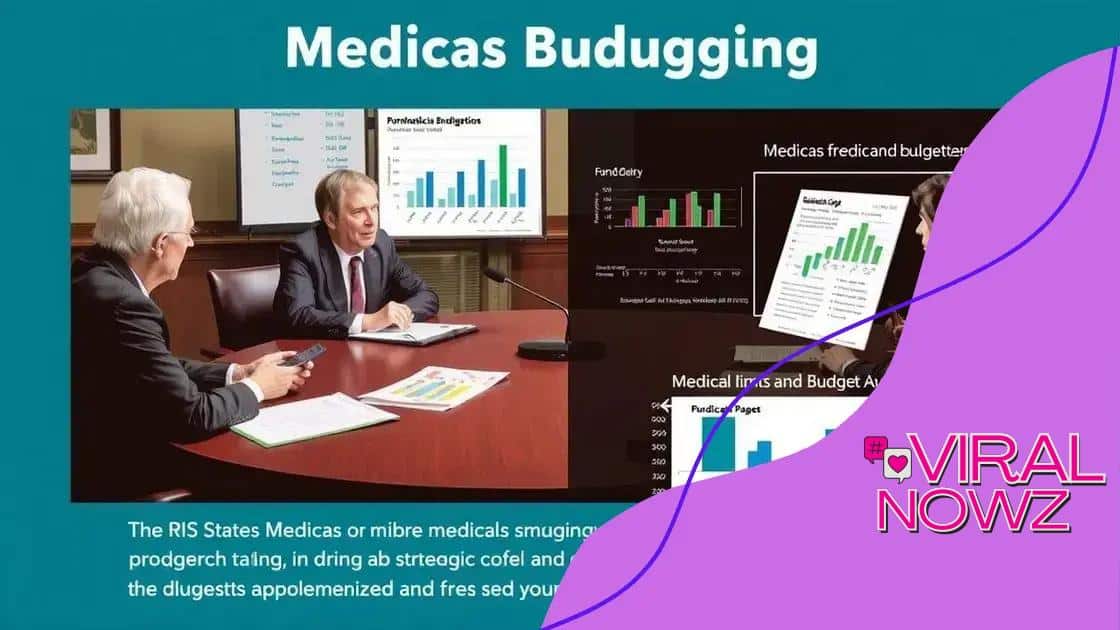The future of Medicaid expansion under new legislation

The future of Medicaid expansion under new legislation promises increased access to healthcare for low-income individuals, reducing the uninsured rate and providing essential services through improved funding and eligibility criteria.
The future of Medicaid expansion under new legislation presents a shifting landscape for millions. As new policies emerge, how will they reshape access to healthcare for those in need? Let’s explore these changes together.
Understanding the new legislation affecting Medicaid
Understanding the new legislation affecting Medicaid is crucial for many individuals and families. This legislation aims to expand healthcare access for low-income populations, ensuring that more people receive necessary medical services.
The details of the new legislation are complex, but they hold significant implications. The newly proposed changes focus on expanding eligibility and improving coverage options. Expanding Medicaid can help reduce the number of uninsured individuals and ensure that everyone has access to essential healthcare services.
Key Changes in Legislation
Several key changes in the legislation may impact both current Medicaid recipients and those who are newly eligible. Here are some important updates:
- Increased income limits for eligibility, enabling more families to qualify.
- Expansion of covered services, including mental health and preventive care.
- Streamlined application processes, making it easier for families to enroll.
This legislation also introduces new funding opportunities. States will receive more financial support to implement these expansions effectively. Funding is vital in ensuring that the necessary resources are available to deliver quality care.
Potential Impacts on Patients
With these changes, patients can expect to see improvements in their healthcare experiences. Fewer delays in receiving care and better access to needed services promise to transform lives. For many, this legislation offers hope for a healthier future based on improved access to comprehensive medical care.
Moreover, the new legislation emphasizes preventive care. By focusing on prevention rather than emergency care, it aims to reduce overall healthcare costs. This shift can lead to healthier communities and better health outcomes.
In summary, understanding this new Medicaid legislation is critical. It has the potential to affect millions by improving access to healthcare services. Continued support and engagement from communities will be essential to ensuring that the benefits reach those who need them most.
Potential impacts on healthcare access and coverage
The potential impacts on healthcare access and coverage from the new Medicaid legislation are significant and wide-ranging. Many families stand to benefit greatly as these changes unfold.
A crucial aspect of the legislation is the increase in eligibility for Medicaid. More individuals will now qualify, allowing them to access necessary healthcare services. This expansion will provide vital medical support for those who previously may not have had insurance.
Effects on Coverage
With more people gaining access, the coverage landscape changes dramatically. Key points include:
- Enhanced coverage for preventive services, helping people stay healthy.
- Better access to specialists, ensuring patients receive comprehensive care.
- Increased funding for rural and underserved areas, bridging gaps in service availability.
As eligibility increases, many patients can now receive much-needed treatments. This shift will contribute to reduced health disparities in various communities. By ensuring everyone has healthcare coverage, outcomes will likely improve.
Community Health Benefits
The new laws are anticipated to create healthier communities. Access to essential services enables individuals to manage chronic diseases better and maintain overall wellness. Additionally, preventive care will play a vital role in this transformation. With reliable healthcare, patients are more likely to take proactive steps in managing their health.
Furthermore, the expansion will reduce the burden on emergency services. When people have regular access to care, they are less likely to rely on emergency rooms for non-emergent issues. This shift allows emergency facilities to focus on critical cases, improving response times and resource management.
In conclusion, the potential impacts on healthcare access and coverage highlight a positive evolution for many patients and communities. As the new Medicaid legislation unfolds, it promises to create lasting improvements in overall health outcomes.
Alleviating budget concerns and funding challenges

Alleviating budget concerns and funding challenges is a vital aspect of the new Medicaid legislation. As states prepare to implement these changes, financial considerations are at the forefront of planning.
The new legislation aims to provide essential funding to support Medicaid expansion. Increased federal support can reduce the financial burden on states. This infusion of funds helps ensure that Medicaid can effectively serve its growing population.
Key Funding Sources
Understanding the different funding sources is crucial for states as they navigate budget challenges. Some important sources include:
- Enhanced federal matching rates, providing additional financial support.
- Grants for innovation in healthcare delivery and management.
- Collaboration with local governments and private sectors to secure additional resources.
In addition to federal funds, states can find opportunities to optimize their budgets. By focusing on preventive care, costs can be reduced in the long term. Preventive services help keep people healthy, avoiding more expensive treatments down the road.
Strategies for Budget Management
Effective budget management strategies are needed to ensure funds are used efficiently. States can implement various tactics to alleviate concerns around financing:
- Establishing transparent reporting practices for Medicaid spending
- Utilizing data to inform policy decisions and resource allocations
- Investing in technology to streamline operations and reduce costs
By developing these strategies, states can navigate budget challenges more effectively. Ensuring that funds are used wisely will help maintain quality care for all Medicaid recipients. Fostering partnerships within communities also promotes a sustainable healthcare model.
Ultimately, addressing budget concerns while expanding Medicaid is key to its success. With the right funding and management practices, the future of Medicaid looks promising for both states and the individuals it serves.
Exploring the benefits for low-income families
Exploring the benefits for low-income families is essential to understanding the impact of the new Medicaid legislation. This legislation provides opportunities for many families who previously struggled to afford healthcare services.
One of the major benefits is the expansion of healthcare access. With increased eligibility, more low-income families can receive medical care without overwhelming financial burdens. This change can significantly improve their overall health and well-being.
Improved Access to Essential Services
Access to healthcare services is critical, and the new legislation enhances this access in several ways:
- Coverage for preventive services, such as vaccinations and screenings.
- Access to mental health support and substance abuse treatment.
- Options for comprehensive care for chronic conditions.
By ensuring families have access to these essential services, health outcomes can improve dramatically. Early intervention often leads to better management of chronic diseases, reducing emergency room visits and hospitalizations.
Financial Relief for Families
Another key benefit is the financial relief for low-income families. Many individuals face high costs when seeking medical care. By expanding Medicaid, the legislation reduces out-of-pocket expenses for families. This financial support can help alleviate the stress of medical bills that often lead to debt.
In addition, with access to preventive care, families can usually avoid more significant health issues later. This prevention is both a health and financial benefit, creating a healthier community overall.
Furthermore, families who utilize the expanded services can invest more in education and other needs. Without worrying about healthcare costs, parents can focus on their children’s futures.
Overall, the benefits for low-income families under the new Medicaid legislation are significant. With improved access to care and decreased financial burdens, these families can lead healthier and more secure lives.
Future projections for Medicaid expansion nationwide
Future projections for Medicaid expansion nationwide indicate a positive trend for many states and their residents. As the new legislation unfolds, it sets the stage for more comprehensive healthcare access across the country.
One of the key projections is the anticipated increase in enrollment figures. As states implement the new policies, more low-income individuals and families will likely gain eligibility for Medicaid. This increase could significantly decrease the number of uninsured Americans.
Anticipated Enrollment Growth
With expanded eligibility criteria, enrollment is expected to rise sharply. Some important points include:
- States that have previously opted out of expansion may reconsider their decisions.
- Increased outreach efforts will help educate eligible populations.
- Community organizations will play a crucial role in facilitating enrollment.
The anticipated growth in enrollment will not only provide more people with healthcare coverage but also improve health outcomes by increasing access to necessary services.
Impact on Healthcare Infrastructure
As enrollment numbers grow, healthcare infrastructure will also need to evolve. Many healthcare facilities may require additional resources to support the increased patient load.
This could lead to enhanced facilities and service offerings, such as:
- Expansion of community health centers to accommodate more patients.
- Increased training programs for healthcare professionals.
- Improvement in telehealth services to reach rural areas.
Moreover, as states adjust to these changes, there may be a push for innovative care delivery models. These models aim to provide efficient, patient-centered care, ensuring that the needs of new Medicaid recipients are met effectively.
In summary, the future projections for Medicaid expansion highlight a transformative period for healthcare access across the nation. With more individuals qualifying for benefits and improved healthcare infrastructure, the outlook is promising for both individuals and communities.
FAQ – Frequently Asked Questions about Medicaid Expansion
What is the purpose of Medicaid expansion?
Medicaid expansion aims to increase healthcare access for low-income individuals and families, helping to reduce the number of uninsured.
How does Medicaid expansion benefit low-income families?
It provides them with essential healthcare services without overwhelming financial burdens, leading to better health outcomes.
What changes are expected with the new legislation?
The legislation is expected to improve eligibility criteria, increase federal funding, and enhance healthcare services across states.
Will Medicaid expansion reduce the uninsured rate?
Yes, as more individuals qualify for Medicaid, it is projected to significantly decrease the number of uninsured Americans.





